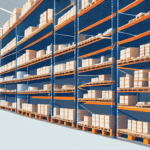Managing Your Raw Materials Inventory for Maximum Efficiency
Efficient inventory management is critical to the success of any manufacturing business. This is especially true for companies that rely on raw materials for product manufacturing. Effective raw materials inventory management can help companies reduce costs, manage risks, increase productivity, and meet customer demand. In this article, we'll explore key concepts and best practices for raw materials inventory management to help you optimize your inventory operations for maximum efficiency.
Understanding the Importance of Inventory Management in Raw Materials
Effective inventory management is essential to prevent stock shortages and excess inventory, reduce operational costs, and improve customer satisfaction by ensuring on-time delivery. According to a Bureau of Labor Statistics report, companies with optimized inventory management can see a cost reduction of up to 20%. Additionally, inventory management helps minimize risks related to supply chain disruptions, such as material shortages or unexpected delays.
Key Benefits of Effective Inventory Management
- Cost Reduction: By maintaining optimal inventory levels, companies can reduce storage costs and minimize capital tied up in excess stock.
- Risk Management: Effective inventory practices help mitigate risks associated with supply chain disruptions.
- Enhanced Productivity: Ensuring the right materials are available when needed boosts overall productivity.
- Improved Customer Satisfaction: Timely delivery of products enhances customer loyalty and satisfaction.
Analyzing Your Raw Materials Supply Chain for Optimal Inventory Management
Analyzing your supply chain is crucial for determining optimal inventory levels based on production needs, supplier lead times, and market demand. Understanding supplier lead times and production schedules ensures that necessary materials are available when needed, thereby preventing delays in production.
Assessing Supplier Reliability and Quality
Working with reliable suppliers who consistently deliver high-quality materials is vital. This reduces the risk of stockouts and production delays. Regular supplier audits and performance evaluations can help identify potential issues early on, allowing for corrective actions before they escalate.
Monitoring Market Demand and Consumer Behavior
Keeping an eye on market demand and changes in consumer behavior helps anticipate inventory requirements. Tools like Statista provide valuable data for forecasting trends and adjusting stock levels accordingly.
The Role of Technology in Improving Raw Materials Inventory Management
Leveraging technology is essential in today's fast-paced business environment. Advanced inventory tracking systems offer real-time updates and visibility into inventory levels and usage, enabling faster and more informed decision-making.
Automating Inventory Processes
Technology can automate key inventory management processes such as ordering and replenishment, reducing the risk of human error and freeing up valuable staff resources. Systems like Oracle Inventory Management streamline these operations effectively.
Enhancing Forecasting Accuracy
By analyzing historical data and market trends, companies can make more accurate predictions about future demand. Tools like Tableau aid in data visualization and trend analysis, helping businesses adjust their inventory levels proactively.
Implementing Lean Principles in Raw Materials Inventory Management
Lean inventory management principles focus on streamlining processes and minimizing inventory without sacrificing quality or reliability. The goal is to reduce waste and eliminate non-value-adding activities.
Adopting Just-in-Time (JIT) Inventory Management
JIT inventory management minimizes inventory levels by ordering materials only as needed for production. This approach reduces storage costs and ensures that materials are fresh and up to standard.
Utilizing Kanban Inventory Control
Kanban systems help ensure that the right amount of inventory is available at the right time. By visualizing workflow and inventory levels, Kanban improves efficiency and reduces lead times.
Best Practices for Reducing Waste and Costs in Raw Materials Inventory Management
Implementing best practices is essential for minimizing waste and reducing costs in inventory management.
Regularly Monitor and Evaluate Inventory Turns
Inventory turnover rate indicates how often inventory is sold and replaced over a period. A higher turnover rate typically signifies efficient inventory management. Tools like Investopedia can help calculate and interpret this metric.
Establish Safety Stock Levels
Setting safety stock levels ensures that unexpected spikes in demand or supply shortages do not disrupt production. This buffer stock acts as a safeguard against uncertainties in the supply chain.
Implement a Rigorous Cycle Counting Program
Cycle counting involves regularly counting a portion of inventory to identify discrepancies or errors promptly. This practice helps maintain accurate inventory records and prevents larger issues from arising.
Developing a Comprehensive Plan for Raw Materials Inventory Forecasting and Replenishment
A comprehensive forecasting and replenishment plan is vital for maintaining optimal inventory levels.
Accurate Forecasting Processes
Incorporate historical trends, market demand, and supplier lead times into your forecasting models. Tools like SAS Forecasting can enhance the accuracy of your predictions.
Strategic Replenishment Strategies
Set clear reorder points and guidelines for when to order new inventory. Automating replenishment tasks using software solutions like SAP Inventory Management can streamline this process.
The Benefits of Collaborating with Suppliers to Improve Raw Materials Inventory Management
Collaborating closely with suppliers offers numerous advantages for inventory management.
Streamlined Communication
Strong relationships with suppliers facilitate clear and efficient communication, ensuring both parties understand inventory needs and lead times.
Optimized Inventory Levels
Sharing data on demand patterns and forecasting with suppliers can help optimize inventory levels, reducing excess stock and minimizing the risk of stockouts.
Cost Savings and Innovation
Collaborating with suppliers can lead to negotiated pricing, cost savings, and access to innovative materials or processes that enhance inventory management.
Overcoming Common Challenges in Raw Materials Inventory Management
Managing raw materials inventory comes with various challenges that businesses must address to maintain efficiency.
Managing Pricing Fluctuations
Price volatility can significantly impact inventory costs. Strategies such as establishing long-term contracts with fixed pricing or diversifying suppliers can help mitigate these risks.
Handling Multi-Location Inventory Management
Managing inventory across multiple locations requires standardized protocols and real-time visibility. Implementing centralized inventory management systems like Netstock can ensure consistency and accuracy.
Ensuring Material Quality
Maintaining high-quality materials is crucial to prevent production delays and additional costs. Implement quality control measures such as regular inspections, setting quality standards with suppliers, and investing in testing equipment.
Measuring Success: Key Metrics for Evaluating Your Raw Materials Inventory Management Strategy
Establishing and monitoring key performance indicators (KPIs) is essential for evaluating the effectiveness of your inventory management strategy.
Essential Metrics to Track
- Inventory Turnover Rate: Measures how often inventory is sold and replaced over a period.
- Carrying Costs: The total cost of holding inventory, including storage, insurance, and taxes.
- Stockouts: The frequency of inventory shortages impacting production and sales.
- Customer Satisfaction: Reflects how inventory management impacts the ability to meet customer demands.
- Supplier Performance: Evaluates the reliability and quality of suppliers based on delivery times and material quality.
Continuous Improvement Through Regular Reviews
Regularly analyzing these metrics allows companies to identify areas for improvement, refine inventory management practices, and adapt to changing market conditions. Utilizing analytics tools such as Power BI can facilitate in-depth analysis and reporting.
Effective raw materials inventory management is a critical component of any manufacturing operation. By understanding the importance of inventory management, analyzing the supply chain, leveraging technology, and implementing lean principles and best practices, companies can optimize their inventory management for maximum efficiency and success. Collaborating with suppliers, overcoming common challenges, and measuring success with key metrics further enable businesses to refine their strategies, stay competitive, and meet customer demands effectively.




















